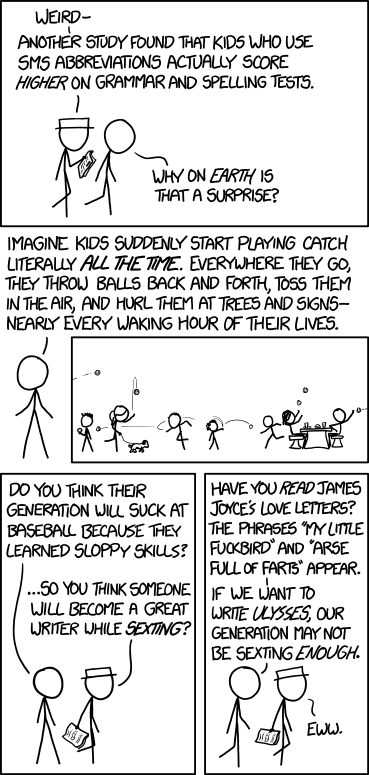Adrienne St. George is our district's Media Center Specialist. She contributes this guest post on teens and technology. You can contact her at adrienne.stgeorge@sduhsd.net.
Technology is NOT going away! That’s not a news flash, is it? The real news is that as the use and acceptance of technology expands, so do the skills of the users, especially those in the 16 – 29 age groups.
Recent reports from PEW, Common Sense Media, and other research centers, show that the use of technology as a whole is increasing dramatically from ages 0 – 60+ with very encouraging trends. The surges of use and skill vary for different age groups and for different end goals.
With the focus on teens and young adults, the research results are amazing. Referred to as millennials, access to media devices for this group has exploded in the past 2 - 3 years. Usage of media devices has more than doubled in that time. Average time of use on a device has tripled in that same time frame. Traditional screen media such as TV, DVD, video games has decreased significantly. TV is still a dominant venue but is now viewed through a DVR, is streamed or viewed from “on demand”. Access to devices is becoming more equitable to all socioeconomic groups. Smartphones are the devices that are used the most.
Why a mobile device? Why a smart phone? Reasons given to researchers:
- Always with us
- Instant information and accessibility anytime/anywhere
- Fingertip action
- Timely info
- Location sensitive
- Instant feedback
- Ability to create our own info and share
Summary of research:Teens live in a different information ecosystem: “There is no playbook for this new environment”
(13 Things to know about Teens and Technology, Pew Project, July 23, 2014.) Teens are not aliens but they are different because they are tied to technology. Technology saturates their lives. Teens are becoming a network of information. Information is another skin…natural, ubiquitous, portable, immediate, timeless, participatory, connected and social. More than 95% of all surveyed have broadband at home, more than 70% have access to the Internet on a mobile device, 78% at least have a cell phone (close to 50% have smartphones), 81% use social networking. End result: data and info is a third skin…it is just normal.
Teens live in a different learning ecosystem: The surveyed College Board and NWP teachers agreed that although technologies are creating a somewhat distracted generation, the internet and digital tools have had a very positive impact on student research. These same teachers strongly believe that the Internet gives students a much wider range of resources than traditional resources. Students know how to access the Internet, use search engines and find information easily. They all agree that while students are very self-sufficient researchers, they believe that a lot of the information found is overwhelming and difficult for students to understand. However, they believe that this is a common problem with traditional research as well. Their main concern for students is the inability to discern bias and validity. Traditional resources were usually considered “pre-validated”. Now students must learn how to validate sources themselves. This is where teachers come in. The surveyed teachers strongly believe that digital literacy needs to be incorporated in daily lesson plans. These teachers stated that exposing students to and teaching them how to use digital resources other than the top three used (Google, Wikipedia and YouTube) would expand research skills, learning and knowledge to even higher levels.
Learning should be a process, rather than an assignment. Teens/young adults create knowledge, rather than receive knowledge. Knowledge is interactive, rather than transmitted in static structures. Learning is active with the learner managing his/her own learning process, rather than passive with the learner just listening and watching.
Overall consensus: Teens/young adults are wired differently and lead very functional hyper-connected lives. Teens are able to handle multitasking seamlessly. Adults claim multitasking skills, yet they are aware of the different tasks they try to accomplish simultaneously, while it is effortlessly integrated in millennials. Multitasking for adults is clunky and obvious; multitasking for the under 30 age group, is fluid and natural.
The majority of survey participants strongly predict that the future, as soon as 2020, is positive for millennials. Millennials will be able to problem solve quickly and efficiently through cooperative work; they will be able to effectively search for information online, discern the quality and veracity, then communicate the findings; they will be able to synthesize and collect details from many sources into a final suggestion/solution; they will have the ability to distinguish between “noise” and the real information in forever growing amounts of data.
I've always been fascinated by what teens/young adults are capable of doing with phones, with tablets, with all of their devices for school and for fun. Teens today are bright and savvy; they want to be challenged. They want to try to do everything on their devices
especially if people tell them it is not possible. It is so nice to hear clear optimism from so many reliable sources that teens really are capable of using technology successfully for learning and probably in ways adults never imagined.
More Teens Use Smart Phones to get Online, eSchool News, 3, 2013
Zero to Eight, Children’s Media Use in America 2013, Common Sense Media Research
Pew Reports:5 Media Spaces Where People Live Digital Age Reading, Writing, ResearchTeens and Libraries in Today’s Digital World13 Things to Know about Teens and TechnologyTeens and Technology 2013



